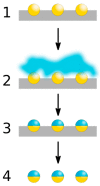Development of Janus Particles as Potential Drug Delivery Systems for Diabetes Treatment and Antimicrobial Applications
- PMID: 36839746
- PMCID: PMC9967574
- DOI: 10.3390/pharmaceutics15020423
Development of Janus Particles as Potential Drug Delivery Systems for Diabetes Treatment and Antimicrobial Applications
Abstract
Janus particles have emerged as a novel and smart material that could improve pharmaceutical formulation, drug delivery, and theranostics. Janus particles have two distinct compartments that differ in functionality, physicochemical properties, and morphological characteristics, among other conventional particles. Recently, Janus particles have attracted considerable attention as effective particulate drug delivery systems as they can accommodate two opposing pharmaceutical agents that can be engineered at the molecular level to achieve better target affinity, lower drug dosage to achieve a therapeutic effect, and controlled drug release with improved pharmacokinetics and pharmacodynamics. This article discusses the development of Janus particles for tailored and improved delivery of pharmaceutical agents for diabetes treatment and antimicrobial applications. It provides an account of advances in the synthesis of Janus particles from various materials using different approaches. It appraises Janus particles as a promising particulate system with the potential to improve conventional delivery systems, providing a better loading capacity and targeting specificity whilst promoting multi-drugs loading and single-dose-drug administration.
Keywords: Janus particle; drug delivery; formulation; pharmacodynamics; pharmacokinetics.
Conflict of interest statement
The authors declare no conflict of interest.
Figures













References
-
- Perro A., Reculusa S., Ravaine S., Bourgeat-Lami E., Duguet E. Design and synthesis of Janus micro-and nanoparticles. J. Mater. Chem. 2005;15:3745–3760. doi: 10.1039/b505099e. - DOI
-
- Auschra S. Von der Fakultät für Physik und Geowissenschaften. der Universität Leipzig; Borna, Germany: 1988. On the Properties of Self-Thermophoretic Janus Particles.
-
- Rahiminezhad Z., Tamaddon A.M., Borandeh S., Abolmaali S.S. Janus nanoparticles: New generation of multifunctional nanocarriers in drug delivery, bioimaging and theranostics. Appl. Mater. Today. 2020;18:100513. doi: 10.1016/j.apmt.2019.100513. - DOI
Publication types
LinkOut - more resources
Full Text Sources

